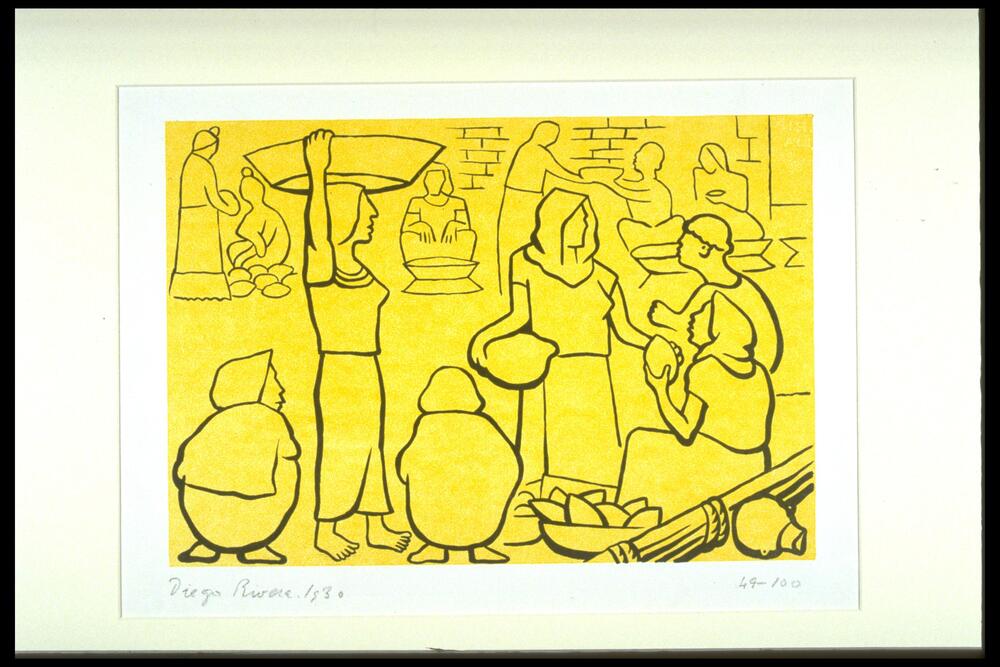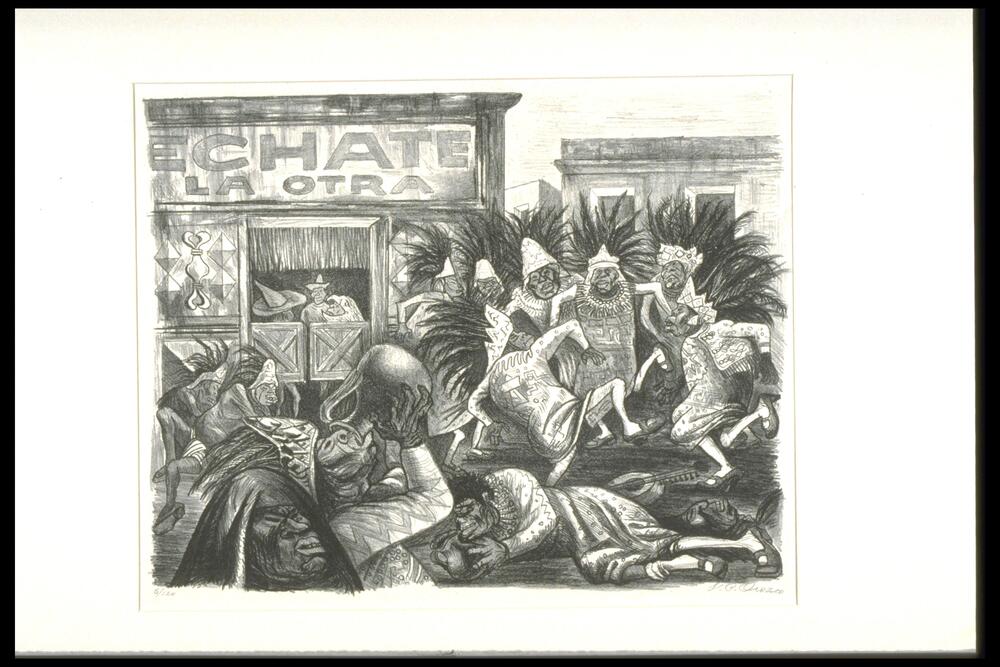Orozco, Rivera, Siqueiros Essay
Understanding Race Essay by Angela Perez-Villa
The artists
The Mexican mural renaissance that took shape shortly after the Mexican Revolution (1910-1920) was an important art movement that radically pushed for a more democratic function of art through mural painting. As Secretary of Education in the 1920s, José Vasconcelos, a liberal intellectual who supported the Revolution, sought to implement educational and cultural policies that would foster artistic creativity and promote the contact of the general public with art.[1] To this end, Vasconcelos commissioned young Mexican artists such as José Clemente Orozco (1883-1949), Diego Rivera (1886-1957), and David Alfaro Siqueiros (1896-1974) to paint the walls of public and administrative buildings throughout Mexico.[2]
In the 1920s and 1930s, the work of these three leading artists—canonized as the big three of Mexican muralism—captured the spirit of post-revolutionary Mexico in ways that celebrated indigenous Mexican culture or emphasized human tragedy and political turmoil. The artists’ active exploration of themes, techniques, and political engagement resulted in the creation of modern Mexican art that was, as described by Anna Indych-López,
Defined by the marriage of European form with content culled from autochthonous culture, often Indian subject matter. Absorbing the lessons of European experimentation—expressionism, cubism, modern classicism—modern Mexican artists forged an art that was national in content and modern in form and technique.[3]
In this sense, the artists appropriated popular culture to their own ends, defining the political character and visual aesthetic of their own murals. Such an approach developed not without a number of contradictions and paradoxes. Orozco, Rivera and Siqueiros all shared a belief in the importance of public art, but their political visions and nationalistic sentiments differed greatly. Rivera, highly influenced by European art, developed his own artistic style entrenched in notions of the Mexican indigenous, rural, and folkloric culture. Orozco and Siqueiros rejected Rivera’s indigenismo.[4] They were committed to produce art that was socially engaged but explicitly critical while promoting a racial ideal around mestizaje and universal culture.[5] Interestingly, however, both Orozco and Siqueiros realized that in order to enter artistic circles in the U.S. and make a living during the Great Depression era, they would have to embrace the “Mexicanism” for which Rivera was known and accommodate their work to “U.S. notions of Mexican art being political, caricatural, and folkloric.”[6]
Technique and content
In the late 1920s and 1930s, printmaking became an important medium for Orozco, Rivera, and Siqueiros. It started when Orozco experimented with versions of his well-known Los horrores de la revolución, a series of ink-and-wash drawings produced between 1926 and 1928 portraying Mexican Revolutionary violence specifically for a North American audience. The disturbing imagery depicted in such drawings – brutal murder, looting, rape, mass slaughter, corporeal devastation – sparked the interest of viewers and this, in turn, stimulated Orozco’s creativity. He saw an opportunity to expand his reach to a broader U.S. audience by making lithographic versions of some of the less violent drawings in Horrores and later of specific images/segments of the murals he painted in the National Preparatory School in Mexico in 1923. This successful strategy not only allowed Orozco to break into the U.S. market with cheaper, portable, and multiple prints, but it also paved the way for both Rivera and Siqueiros to explore the medium initially through the recreation of images from their own murals.[7]
In the 1930s, lithography, thus, became an avenue for the artists to supplement their income, broaden their audience, and explore an array of politically and socially inspired themes. On this last point, the prints exhibited the artists’ different approaches to sociopolitical issues, revealing the particular ways in which they understood and captured everyday life in their work. Like his murals, Rivera’s prints promoted Mexican cultural nationalism through folkloric images that cemented his affinity for indigenismo. His approach glorified the rural character of Mexico by depicting picturesque scenes of revolutionary victory and Indian men and women working in fields, selling and buying food in street markets, engaging in traditional folk dances and others. These colorful and peaceful images of traditional peasant culture and identity celebrated an indigenous past and its role in an emerging nationalism in post-revolutionary Mexico.
Orozco and Siqueiros opposed Rivera’s style and “individually condemned the aesthetics and ideology of official indigenismo.”[8] In his prints, Orozco employed an often-described dark, pessimistic style, exemplified by images of war, death, misery, dislocation, and stereotypes. In this way, Orozco sought to distinguish his work from that of Rivera, presenting a different thematic angle for a growing U.S. audience. Orozco argued that his work was the product of his own disinterested artistic passion and not of a particular political commitment. In spite of such affirmations, it is difficult to disassociate Orozco’s art from the political contexts in which it emerged. For example, in the mid 1930s, his lithographs Hanged Men and Pulquería, both in the UMMA collections, respectively depicted images of racial violence against blacks and stereotypical perceptions of indigenous Mexican men. These images “demonstrate a compassion for the oppressed and are an invective against social injustice” at a time when racial minorities suffered violent attacks throughout the United States. Interestingly, however, art historians such as Anna Indych-López have noted that Orozco “did not aim to direct behavior [social activism] because he did not think such a thing was possible.”[9]
Similarly, Siqueiros rejected the positive indigenista themes by producing images that captured the anguish and sadness of Mexican indigenous people as well as the tragedy that manifested itself in different forms throughout the natural landscape after the revolution. In some ways, Siqueiros combined two of the most important elements that defined the work of Orozco and Rivera: he opted for a non-folkloric style like the former while openly politicizing his work like the latter. As an active member of the communist party, Siqueiros criticized the popularization of Mexican folklore for its intention to please tourist curiosity and disguise U.S. imperialism.[10] But the U.S. offered a market for the somber and tragic imagery in his work, which ultimately led him to participate in this market in order to succeed as an artist while in exile in the late 1920s.
Object information
Diego Rivera (1886-1957)
Market Place (1930)
Color lithograph
1950/1.172
In this color lithograph, Rivera presents a scene at a market where barefoot men and women interact and exchange food products. The faceless figures in this image are shown standing, sitting and squatting. The women wear skirts and veils that cover their heads. One woman holds a big tray on her head and another, next to her, holds a basket close to her hip and negotiates for fruits or vegetables.
José Clemente Orozco (1883-1949)
Pulquería
Lithograph
1954/1.161
In this lithograph, Orozco combines caricatural humor and satire to depict a group of Indian men outside of a pulquería, a workingmen’s bar named Échate la otra (Have Another One). Two men are wearing breechcloths while the others are wearing traditional feather headdresses and long sleeve dresses with geometrical patterns along with knee-high socks and shoes. The combination of these items of clothing signals the mixed character of Mexican popular culture, that of the primitive and the civilized. Dancing recklessly and drinking to the point of passing out suggests, however, a lack of civility that perpetuates their status as primitive. The men’s exaggerated facial features and gestures – pronounced cheekbones, square jawlines, wide nostrils, and full lips – add to the stereotypical image of the Indian as being aesthetically unpleasing and undesirable. Interestingly, inside the pulquería are three figures that look different. Two of them are wearing traditional Mexican sombreros (hats) while the other has an eagle mask over his head.
David Alfaro Siqueiros (1896-1974)
The Child Mother
Lithograph
1958/1.111
In this lithograph, Siqueiros depicts the image of an indigenous girl with a baby strapped to her back. She is wearing a white ragged dress and walking barefoot in a mysterious and nebulous setting. Her eyes are big and they stare intently at something behind her.
Her baby is looking in the same direction with a slight frown on her face suggesting fear or concern. The girl’s dress is torn. She is using her left hand to pull up her dress.
Teaching ideas
General discussion questions:
- Who is depicted in each of these prints?
- Describe what the central figures in the prints are doing.
- In what ways do these prints relate to one another?
- Do the artists share a similar idea/vision of the meaning of indigenous identity in Mexico? Why or why not?
- In what ways are the images in these prints humorous, sad and/or traditional?
2. These objects can be used in a class of contemporary Latin American history to learn about the ways that Latin American artists in the early twentieth century grappled with the social and political issues of their time. In the particular case of Mexico, these objects offer rich material to discuss, among other things, the cultural legacy of the revolution, the cultural representation of indigenous people in Mexico and in the U.S., and the significance of race in the process of imagining and portraying a national identity.
- Describe the ways in which each of these artists embraces or rejects indigenismo through their work.
Resources
Indych-López, Anna. Muralism Without Walls: Rivera, Orozco, and Siqueiros in the United States, 1927-1940. Pittsburgh: University of Pittsburgh Press, 2009.
O’Connor, Francis V. "Orozco, José Clemente." In Grove Art Online. Oxford Art Online, http://www.oxfordartonline.com.proxy.lib.umich.edu/subscriber/article/grove/art/T063949 (accessed May 18, 2012).
O’Connor, Francis V. “Rivera, Diego.” In Grove Art Online. Oxford Art Online, http://www.oxfordartonline.com/subscriber/article/grove/art/T072302?q=diego+rivera&search=quick&pos=1&_start=1#firsthit (accessed June 18, 2012).
O’Connor, Francis V. "Siqueiros, David Alfaro." In Grove Art Online. Oxford Art Online, http://www.oxfordartonline.com/subscriber/article/grove/art/T078971 (accessed June 18, 2012).
Orozco, Clemente. José Clemente Orozco: Graphic Work. Austin: University of Texas Press, 2004.
Rochfort, Desmond. Mexican Muralists: Orozco, Rivera, Siqueiros. New York: Universe Publishing, 1993.
[1] Desmond Rochfort, Mexican Muralists: Orozco, Rivera, Siqueiros (New York: Universe Publishing, 1993), 20.
[2] José Vasconcelos believed that the mestizo embodied the Mexican national consciousness. Through his art commissions and writings, such as his book entitled “The Cosmic Race”, Vasconcelos promoted a nationalist rhetoric that celebrated mestizaje—the fusion of various races and cultural traditions. Vasconcelos actively praised the redemptive power of European culture in Mexico as a government official until the early 1930s when “state-sponsored artistic practice had shifted away from Vasconcelian mestizo universalism to official indigenismo and more populist rhetoric” (Indych-López 103).
[3] Anna Indych-López, Muralism Without Walls: Rivera, Orozco, and Siqueiros in the United States, 1927-1940 (Pittsburgh: University of Pittsburgh Press, 2009), 103.
[4] Indigenismo was part of the nationalist ideology that emerged in Mexico after the Revolution of 1910. Mexican cultural elites such as Rivera celebrated Mexicanness as a nativist, indigenous identity vested in folkloric culture. According to Indych-López, “the valorization of Indian aesthetics became the primary means by which official indigenismo ‘sought to incorporate Indian communities into modern Mexico’” (Indych-López, 87).
[5] Mestizaje stood in sharp contrast to indigenismo. As an ideology it promoted the fusing together of cultures and the mixing of races.
[6] Indych-López, Muralism, 57.
[7] Indych-López, 71.
[8] Indych-López, 103.
[9] Indych-López, 48.
[10] Indych-López, 103.
Part of 2 Learning Collections
<p>Understanding Race Essay by Pamela Reister</p>
<p><br></p>
<p><span style="font-size: 14px;">History of wester...
<p><br></p>
<p><br></p>
<p><br></p>
<p>Understanding Race Essay by Pamela Reister</p>
Created For
K-12 EducatorK-12 Student
Museum Visitor
UMMA Docent
UMMA Staff
University Faculty
University Student
Rate this Resource
AVG: 0 | Ratings: 0
& Author Notes
Creative Commons by-nc-saLast Updated
March 7, 2017 11:17 a.m.Report
Reporting Policy





